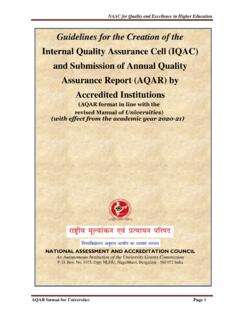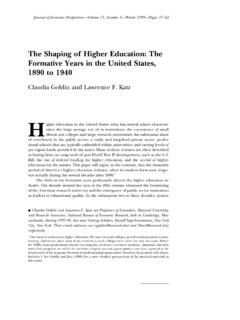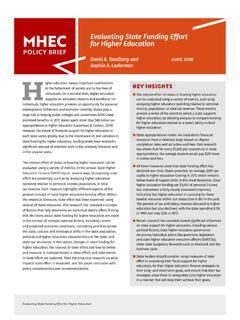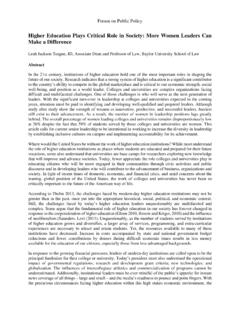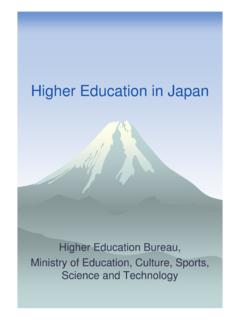Transcription of Quality Assurance in Higher Education
1 Quality AssuranceinHigher EducationAn IntroductionNational Assessment and Accreditation CouncilBangalore, IndiaCommonwealth of LearningVancouver, Canadacyan magenta yellow blackQuality Assurance in Higher Education : An IntroductionAuthor:Dr. Sanjaya Mishra is a Reader at the Staff Training and Research Institute of DistanceEducation at the Indira Gandhi National Open University, New Delhi. He can be reached work was supported by the National Assessment and Accreditation Council (NAAC) ofthe University Grants Commission (Government of India) and the Commonwealth of Learning(COL). The opinions expressed and arguments raised here are solely those of the author anddo not necessarily reflect those of NAAC or COL. NAAC, June 2006 ISBN 81-09842-00-5 Published byThe DirectorNational Assessment and Accreditation Council (NAAC)P. O. Box No. 1075, NagarbhaviBangalore - 560 072 Karnataka, INDIAP hone: +91-80-23210261/61/62/63 Email: Collaboration withCommonwealth of Learning (COL)Suite 1200, 1055 West Hastings Street,Vancouver BC V6E 2E9 CANADAP hone: +1-604-775-8200 Fax: +1-604-775-8210 Email: design : Joshua DavidPrinted atJwalamukhi Job Press# 44/1, Road, Basavanagudi,Bangalore- 560 : 080-26601064iiBlackFOREWORDThe Commonwealth of Learning (COL) is proud to be a partner with the National Assessment andAccreditation Council (NAAC) in bringing out the Quality Assurance in Higher Education : AnIntroduction , a volume which aims to address the needs of the generalist and the specialist; thepolicy maker as well as the practitioner.
2 It also signals the expansion of NAAC s mandate from anorganization which assesses and accredits institutions to one that would promote a culture of is here that the interests of COL and NAAC converge and we hope that this Module will movebeyond India and will have relevance in other jurisdictions across the me begin with the obvious question: What is Quality ? I define Quality simply as fitness for purposeat minimum cost to society . Many countries are debating whether their tertiary Education systemsare indeed fit for use, in the sense of providing the Education and training that students and societyneed. In developing countries, where resources are scarce, countries should not waste them oninstitutions that are not fulfilling important purposes. For India today, Quality in Higher Education is akey priority. And this must be achieved keeping in mind the issues of relevance, costs, equity andinternational do we promote a culture of Quality within institutions of Higher learning?
3 What would be theelements of such a culture? How can different institutions handle such challenges? Do such institutionsrequire a different kind of leadership? Do they need a more decentralized, dialogic and democraticstyle of management? How does one generate a sense of ownership among the staff so that theyare motivated to align themselves to institutional goals and give their best? What resources andtraining are needed? How can monitoring and evaluation become part of all processes, systems andsub-systems of institutions? What makes an institution reflect on its practice and commit to a continuousquest for excellence? Can the use of new ICTs help? With the increasing convergence of face-to-face, ODL and eLearning systems, is there need for separate Quality Assurance mechanisms or arethe same criteria applicable to all systems? Are Quality Assurance agencies exclusive clubs? Whatlevel of credibility have they established? Who will accredit the accreditors?
4 What is the role ofindividuals in creating cultures of Quality ? What role can best practices play? Or do we move beyondreliance on best practices to what C. K. Prahalad calls next practices? As he says: It is advisable tofollow not just best practices, but to develop next practices to blaze a trail and stay ahead of thepack! Rapid expansion in the developing world will change the profile of global tertiary Education . Distancelearning will play a role in this expansion because it fulfils the basic Quality criterion of being fit forpurpose at minimum cost to society. Quality Assurance systems will also have to meet this can best do so by helping institutions evolve towards a culture of Quality . This implies that themajor challenge for Quality Assurance in the years ahead is capacity building at all levels. Thepublication of this Module is a step in the right John DanielPresident and CEO, Commonwealth of LearningiiiBlack Red iiiPREFACEThe idea of Quality is not new, nor that of Quality Assurance (QA).
5 Neither, for that matter, are ourconcerns on Quality . Over the years, numerous books have been written by experienced qualityprofessionals to provide an appreciation for those aspects of Quality that are of practical these are meant largely to meet the needs of personnel engaged in Quality Assurance . For thosewho are not professionals in the field, but still desire to have a preliminary knowledge of the qualityassurance processes and procedures, the need for a simple unified introduction to the subject book is written in an attempt to fill that void in the QA are different approaches to Quality Assurance . The meaning of Quality Assurance may varydepending on the field of activity. Different countries have evolved QA models for their Higher educationsystems as necessitated by their unique national contexts. Nevertheless, in all activities related toquality Assurance across the world, there lies a common unifying thread that laces together thebasic concepts.
6 This book discusses the current QA vocabulary, the prominent models and differentpractices in use in Quality Assurance sector in general and Higher Education in set of typical user profiles in the Module Overview describes the targeted readership range. Inchapters where the Indian context is specifically in focus, the arguments are so presented that theyretain their validity without much loss of generality when extended to other instances as well. Afterexplaining concepts of Quality , a brief history of Quality movement and the pioneering ideas of leadingthinkers on Quality as also their implications for Higher Education are described. Subsequent chaptersdeal with perspectives on Quality , its assessment methodologies and tools for its assessment. Tosustain the relevance to the international reader, a mix of generic models of QA globally in use andIndian models along with international QA practices are explained in chapters 7 and 8. Suggestiveways to build a culture of Quality and a summarized account of QA in Open Distance Learning areincluded in chapter 9.
7 The end-of-chapter reflective exercises are included to help the reader todraw maximum benefit from the text. As the book is aimed at the general reader, the essentialtechnical matter is couched in general terms. For the very same reason, an appropriate glossaryexplaining technical terms is also included. Practical illustrations, where concepts may otherwise beobscure, are included. The web links and references cited at the end of the book should facilitatethe interested reader to pursue the subject in greater time to time, the National Assessment and Accreditation Council (NAAC) has been bringingout publications that provide insights into the Indian example in Quality Assurance . This book is anoutcome of collaboration between NAAC and the Commonwealth of Learning (COL). This is the firstin the series on Quality Assurance in Higher Education , being planned by NAAC in collaboration withCOL, with the twin objectives of raising general Quality awareness as well as developing qualityassessment competencies.
8 It is hoped that the readers will find the contents not only academicallyenriching, but also of practical value in their Quality Red ivAcknowledgementsDr. Sanjaya Mishra, the author, has spared no effort to keep the simplicity and versatility of the bookhigh. I heartily congratulate him for this effort. It is our privilege to work in association with the COLin this venture. Our particular thanks go to Sir John Daniel, President and CEO, COL, Dr. AshaKanwar, Vice-President, COL and Prof. Mohan Menon, Education Specialist, COL for their consistentguidance and help. I am grateful to Prof. Ram Takwale, former Chairperson, EC, NAAC, duringwhose term this venture was conceived and Prof. Goverdhan Mehta, Chairperson, EC, NAAC for hiscontinued encouragement and support for all Quality enhancing activities. It is practically impossibleto acknowledge the help and guidance of everyone who assisted in the preparation of this book, butmention must be made of the distinguished academicians and my colleagues at NAAC, who madenumerous suggestions for improvement of the book.
9 Special thanks and appreciation are due to mycolleagues, Dr. K. Rama, who played a commendable role in coordinating this work and WahidulHassan, for coordinating the publication aspects of the book, and Joshua David for editorial help.(V. S. Prasad)Director, NAACvBlack Red vABBREVIATIONSAB: Accreditation BoardABET: Accreditation Board for Engineering and TechnologyAICTE: All India Council for Technical EducationAPQN: Asia Pacific Quality NetworkAUQA: Australian Universities Quality AgencyCHEA: Council on Higher Education AccreditationCMM: Capability Maturity ModelCMMI: Capability Maturity Model IntegrationCOA: Commission on AccreditationCOPA: Council on Post-secondary AccreditationCORPA: Commission on Recognition of Post-Secondary AccreditationDEC: Distance Education CouncilDEI: Danish Education InstituteDip.: DiplomaENQA: European Association for Quality Assurance in Higher EducationECPD: Engineer s Council for Professional DevelopmentEQM: External Quality MonitoringFRACHE: Federation of Regional Accrediting Commission of Higher EducationGOI: Government of IndiaHEI: Higher Education InstitutionICAR: Indian Council of Agricultural ResearchIGNOU: Indira Gandhi National Open UniversityICT: Information and Communication TechnologyIHEP: Institute of Higher Education PolicyINQAAHE: International Network for Quality Assurance Agencies in Higher EducationIQAC: Internal Quality Assurance CellISO: International Organization for StandardizationJUSE: Japanese Union of Scientists and EngineersMCETYA: Ministerial Council on Education , Training and Youth AffairsMoA: Memorandum of UnderstandingNAAC: National Assessment and Accreditation CouncilNBA: National Board of AccreditationNET: National Eligibility TestNIST: National Institute of Standards and TechnologyODE-AAB.
10 Open and Distance Education Assessment and Accreditation BoardODL: Open and Distance LearningPDCA: Plan-Do-Check-ActPDSA: Plan-Do-Study-ActPG: Post GraduatePoA: Programme of ActionQAA: Quality Assurance AgencySPC: Statistical Process ControlTQM: Total Quality ManagementUG: Under GraduateUGC: University Grants CommissionUNESCO: United Nations Educational, Scientific and Cultural OrganizationUSDE: United States Department of EducationviBlack Red of Figures and of Quality ..113 History of Quality of Quality in Higher can Quality be Assessed?..306 Tools for Quality of Quality a Culture of 1: INQAAHE Good Practice 2: ENQA Standards and Guidelines ..92 Feedback Form ..95viiBlack Red viiLIST OF FIGURES AND TABLESF igures PageFig. 1: Concept Map4 Fig. 2: Systems Approach28 Fig. 3: Admission Process in a Programme36 Fig. 4: Line Diagram36 Fig. 5: Histogram37 Fig. 6: Fish-bone Diagram38 Fig. 7: Five Levels of Software Process Maturity47 Fig.





